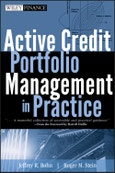Filled with in-depth insights and expert advice, Active Credit Portfolio Management in Practice serves as a comprehensive introduction to both the theory and real-world practice of credit portfolio management. The authors have written a text that is technical enough both in terms of background and implementation to cover what practitioners and researchers need for actually applying these types of risk management tools in large organizations but which at the same time, avoids technical proofs in favor of real applications. Throughout this book, readers will be introduced to the theoretical foundations of this discipline, and learn about structural, reduced-form, and econometric models successfully used in the market today. The book is full of hands-on examples and anecdotes. Theory is illustrated with practical application. The authors' Website provides additional software tools in the form of Excel spreadsheets, Matlab code and S-Plus code. Each section of the book concludes with review questions designed to spark further discussion and reflection on the concepts presented.
Table of Contents
Foreword xi
Preface xiii
Acknowledgments xxvii
CHAPTER 1 The Framework: Definitions and Concepts 1
What Is Credit? 2
Evolution of Credit Markets 7
Defining Risk 11
A Word about Regulation 13
What Are Credit Models Good For? 14
Active Credit Portfolio Management (ACPM) 16
Framework at 30,000 Feet 19
Building Blocks of Portfolio Risk 23
Using PDs in Practice 32
Value, Price, and Spread 34
Defining Default 38
Portfolio Performance Metrics 38
Data and Data Systems 42
Review Questions 43
CHAPTER 2 ACPM in Practice 45
Bank Valuation 50
Organizing Financial Institutions: Dividing into Two Business Lines 52
Emphasis on Credit Risk 57
Market Trends Supporting ACPM 59
Financial Instruments Used for Hedging and Managing Risk in a Credit Portfolio 60
Mark-to-Market and Transfer Pricing 63
Metrics for Managing a Credit Portfolio 68
Data and Models 72
Evaluating an ACPM Unit 75
Managing a Research Team 77
Conclusion 86
Review Questions 87
Exercises 87
CHAPTER 3 Structural Models 89
Structural Models in Context 91
A Basic Structural Model 95
Black-Scholes-Merton 100
Valuation 107
Modifying BSM 117
First Passage Time: Black-Cox 118
Practical Implementation: Vasicek-Kealhofer 124
Stochastic Interest Rates: Longstaff-Schwartz 145
Jump-Diffusion Models: Zhou 150
Endogenous Default Barrier (Taxes and Bankruptcy Costs): Leland-Toft 151
Corporate Transaction Analysis 156
Liquidity 159
Other Structural Approaches 161
Conclusion 171
Appendix 3A: Derivation of Black-Scholes-Merton Framework for Calculating Distance to Default (DD) 171
Appendix 3B: Derivation of Conversion of Physical Probability of Default (PD) to a Risk-Neutral Probability of Default (PDQ) 177
Review Questions 179
Exercises 179
CHAPTER 4 Econometric Models 183
Discrete-Choice Models 186
Early Discrete-Choice Models: Beaver (1966) and Altman (1968) 191
Hazard Rate (Duration) Models 196
Example of a Hazard-Rate Framework for Predicting Default: Shumway (2001) 204
Hazard Rates versus Discrete Choice 206
Practical Applications: Falkenstein et al. (2000) and Dwyer and Stein (2004) 207
Calibrating Econometric Models 215
Calibrating to PDs 216
Calibrating to Ratings 227
Interpreting the Relative Influence of Factors in Econometric Models 234
Data Issues 238
Taxonomy of Data Woes 241
Biased Samples Cannot Easily Be Fixed 244
Conclusion 249
Appendix 4A: Some Alternative Default Model Specifications 249
Review Questions 252
Exercises 252
CHAPTER 5 Loss Given Default 255
Road to Recovery: The Timeline of Default Resolution 258
Measures of LGD (Recovery) 260
The Relationship between Market Prices and Ultimate Recovery 265
Approaches to Modeling LGD: The LossCalc (2002, 2005) Approaches and Extensions 273
Conclusion 285
Review Questions 286
Exercises 286
CHAPTER 6 Reduced-Form Models 289
Reduced-Form Models in Context 291
Basic Intensity Models 296
A Brief Interlude to Discuss Valuation 310
Duffie, Singleton, Lando (DSL) Intensity Model 312
Credit Rating Transition Models 329
Default Probability Density Version of Intensity Models (Hull-White) 340
Generic Credit Curves 348
Conclusion 353
Appendix 6A: Kalman Filter 354
Appendix 6B: Sample Transition Matrices 357
Review Questions 358
Exercises 358
CHAPTER 7 PD Model Validation 361
The Basics: Parameter Robustness 367
Measures of Model Power 371
Measures of PD Levels and Calibration 379
Sample Size and Confidence Bounds 396
Assessing the Economic Value of More Powerful PD Models 418
Avoiding Overfitting: A Walk-Forward Approach to Model Testing 431
Conclusion 437
Appendix 7A: Type I and Type II Error: Converting CAP Plots into Contingency Tables 438
Appendix 7B: The Likelihood for the General Case of a Default Model 440
Appendix 7C: Tables of ROC ε and nmax 441
Appendix 7D: Proof of the Relationship between NPV
Terms and ROC Terms 441
Appendix 7E: Derivation of Minimum Sample Size Required to Test for Default Rate Accuracy in Uncorrelated Case 446
Appendix 7F: Tables for Lower Bounds of ε and N on Probabilities of Default 447
Review Questions 452
Exercises 452
CHAPTER 8 Portfolio Models 455
A Structural Model of Default Risk 460
Measurement of Portfolio Diversification 460
Portfolio Risk Assuming No Credit Migration 461
Structural Models of Default Correlation 465
Credit Migration 470
A Model of Value Correlation 475
Probability of Large Losses 481
Valuation 484
Return Calculations 488
Risk Calculations 491
Portfolio Loss Distribution 498
Capital 514
Economic Capital and Portfolio Management 519
Improving Portfolio Performance 521
Performance Metrics 526
Reduced-Form Models and Portfolio Modeling 530
Correlation in Intensity Models 531
Copulas 534
Frailty 536
Integrating Market and Credit Risk 541
Counterparty Risk in Credit Default Swaps (CDS) and Credit Portfolios 544
Conclusion 546
Review Questions 547
Exercises 548
CHAPTER 9 Building a Better Bank: A Case Study 551
Description 552
Current Organization 554
Transforming the Capital Allocation Process 556
Portfolio Analysis 558
Active Credit Portfolio Management (ACPM) 562
Data, Systems, and Metrics 563
ACPM and Transforming the Bank 566
Appendix: Figures 569
Exercises 574
References 575
About the Authors 589
Index 591








